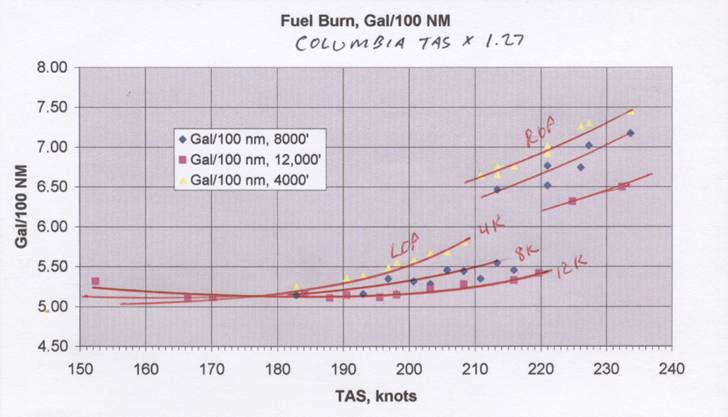It is tough to get repeatable, consistent, accurate
performance figures. It requires agreeable weather and very precise and
patient flying with carefully calibrated instruments. I went through a
careful calibration process so that my IAS and Chelton TAS are now accurate to
better than 1.6 knots across the speed range. It took a lot of fussing
with the static ports. Once the airspeed instruments were calibrated, I
collected performance data at a variety of power settings and altitudes.
A lot of it ended up being poor (lots of scatter) when plotted and checked for
consistency. Grrr……
So I cheated.
I took the best (least scatter, most consistent) sets of
runs for my typical cruise conditions (8500 Feet, 55-65% power,50F lean of
peak) and then compared to the Cessna/Columbia 350 performance tables from the
pilots operating handbook that was once available at the Columbia web site.
I found that if I multiplied the Columbia 350 speed by 1.27, I got a very good fit over the
full speed range I have examined.
I then plotted the modified Columbia figures and with an Excel spread sheet I generated
tables and then curves for gallons/100 nautical miles as a measure of fuel
economy. I argue that this provides the best measure of comparative
operating costs, better than miles per gallon which distorts the presentation.
Here are the results.

These curves support previous suggestions for economical
flying: fly slower, fly higher, and fly lean of peak.
Except: you will note that at higher altitudes the curves
flatten out a lot so that at 12,000 feet, the curve is fairly flat over a wide
speed range. The cost penalty for increasing from say 180 knots (near the
best L/D for the LIV at 12,000 feet) to 220 knots, a 22% speed increase, is
only about 6-7% increase in cost per mile.
But the cost of cranking it up to 75% and running rich of
peak is +20% in cost while gaining only about +6% in speed. Or, if you
like, it costs 20% more to arrive 3.6 minutes sooner for each hour of flight.
So I would say that for my airplane, 65%, 12,000 feet, and
~220 knots is a good trade-off. You Legacy guys are a bit faster, but I
would think the same conclusion applies.
Fred Moreno